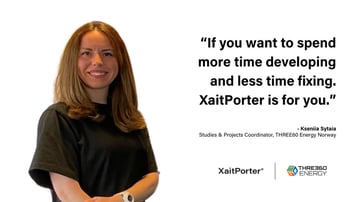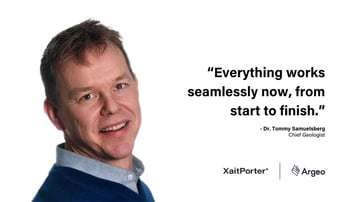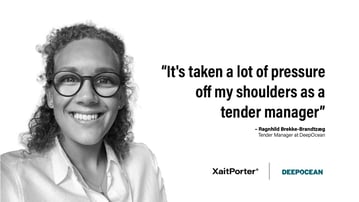When done well, proposal reviews provide a valuable deliverable; feedback on where the team may have blinded themselves to compliant issues and solution or strategy weaknesses, and recommendations on how to improve readability and impact.
Your success relies in how well each proposal review is managed. Leveraging best practices will help you improve review team productivity, empower consensus among reviewers, and drive specific revision instructions, rather than just opinions, that raise your competitiveness and increase your win probability.
Join us as we explore best practices in the proposal review process.
Pre-Reviewing Plan
A productive proposal review begins with independent, knowledgeable reviewers. Independent reviewers bring a fresh pair of eyes for distance and objectivity. Knowledgeable reviewers provide expertise for accuracy and understanding that brings context and the voice of the customer to the proposal. The right number and mix of reviewers depends on the size, scope, and complexity of your pursuit, as well as the size and goals of your organization.
Challenge: Conflicting priorities and shifting deadlines mean reviewers work in a silo, leaving scope and perspective to the proposal manager. The result is feedback based on opinion, and conflicting opinions at that. When reviewers aren’t on the same page, they will struggle to provide the team with helpful, cohesive direction and instruction. And contributors will struggle to improve your proposal.
Best Practice: Whether you leverage Shipley Color Team Reviews, a more agile approach, or define your own review strategy, don’t skip a content writing plan review, or Shipley's Pink Team Review. Early buy-in on how the team will write to the capture, or win, strategy is one of the best ways to avoid rewriting, or worse, a massive, mid-proposal strategy course change.
Give your review team a game plan. Gather and discuss the win strategy, proposal outline and scoring criteria. Highlight areas of compliance and identify specifically what needs to be validated. Agree on overall style, voice, and word choice.
If you are conducting multiple reviews throughout the writing process, assign each review a focus. For example, an early review might focus on confirming the proposed solution and validating win themes and proposal themes, while a later review might focus on customer focus and scoring.
Consider assigning each reviewer a specific review mandate as well, for example solution functionality vs. solution technology or win themes vs. customer voice.
It is easy to assume reviewers are all pulling in the same direction. Confirm this by discussing your aims together. Beginning each review with a brief pre-review game plan ensures reviewers are on the same page and focused on revisions that drive improvement, not correction or course change.
Instructions, Not Feedback
Each review step in your proposal process may have a different focus (first draft, second draft, Pink Team, Red Team). Each reviewer may have a different assigned mandate, (compliance, solution, strategy). Yet, review teams all have one common, overarching goal; advancing proposal win probability. The results of each review are the roadmap that helps the team achieve this goal during revisions.
Challenge: Many of the reviewer comments are unhelpful or uninspired, such as “this is weak” or “this needs more”. Or they are unclear, such as “add more here” or “this doesn’t make sense”. They are mostly useless, and many went in the “round file.” Feedback like “this is weak” doesn’t help you. The team has invested valuable time for nothing.
Best Practice: When you ask a generic question like “feedback,” you should expect a generic answer like, “this is weak.” Instead, ask a specific question like “how can I improve this section” or “how can I support this win theme”? This small adjustment in reviewer mind-set will transform a “this is weak” comment into an “add this proof point to strengthen the section” instruction.
Take this specificity a step further having reviewers assign each comment with a category, such as win theme or deficiency. This provides the proposal manager with a valuable post-review, or "hot wash" tool; sorting and prioritizing exactly what is incorporated into your proposal before the team takes action. If time is tight, you’ll want to assign instruction categories that prioritize “weaknesses” over “strengths” so you address those compliance issues first. Above all, give your reviewers time; taking time to think and provide good instructions now saves wasted time trying to clarify confusion and revise based on bad instructions later.
Proposal reviews are hard work and there is never enough time to review, or revise, everything. It would exasperate most reviewers to know how many of their comments end up in the “round file” due to lack of clarity. Being specific helps reviewers focus on the result you want; insightful instructions that help the team improve quality, i.e., helping evaluators understand, and accept, your solution at a deeper level.
Suggested content



Come to Consensus
Proposal reviews are all about consensus; identifying what needs to be fixed or strengthened, and agreeing on how to fix or strengthen it. It is the difference between one reviewer’s opinion or preference and what is right for the proposal. It requires active participation and a commitment to finding the best “fix” that advances proposal quality without impacting compliance.
Conduct as many, or as few, reviews as necessary, just remember, consensus saves time and drives quality.
Challenge: While the friction between differing opinions or viewpoints is great for innovating solutions and strategies, win themes and proposal themes, it is deadly when trying to improve proposal quality. When reviewers have no visibility into what the other reviewers are thinking and suggesting, they cannot come to consensus on the instructions. When reviewers fail to come to consensus, they deliver redundant, disjointed, and conflicting instructions. This means the proposal manager must spend time mediating different opinions before the team can dive back into writing, or risk confusion and delays among the writing team.
Best Practice: Rethink review access. Email may have revolutionized the way we work, but online, centralized reviews have revolutionized the way we review together. So has co-authoring; teams don't have to bring writing to a halt to review anymore. Despite diverse geographic locations, and conflicting priorities and shifting deadlines, each reviewer will see each other’s work. They can discuss differing opinions, track the conversation within the document, and come to consensus in real time.
Whatever approach you define, consensus requires collaboration. Collaboration promotes a team conversation with a center, rather than from all sides, so that everyone is on the same page. It drives consensus so the team focuses on advancing proposal quality given the time available. And it optimizes writing time.
At the same time, if they review separately on their own schedule, they can see what others have suggested and build off differing opinions to come to consensus. This also gives the proposal manager a competitive, time-saving edge. While the team is reviewing, the proposal manager can monitor how they’re doing. They are alerted as new review instructions are published. They can view the review team's work to date and take steps to clarify instructions before the review window closes.
Finally, schedule a post-review debrief. A productive reviewer-to-writer dialogue collaboration aligns review instructions with revision execution, reducing confusion, and ensuring everyone, no matter where or when they work, is on the same page moving forward.
Proposal Review Process Takeaway
Crafting a winning proposal is a time-consuming business investment. And it may take many review cycles to achieve the proposal quality required to be competitive. Teams who adopt a more accessible, more collaborative review process will save time and deliver the instruction roadmap necessary to advance your proposal win probability. Ready to take the next step towards a collaborative proposal review process?









